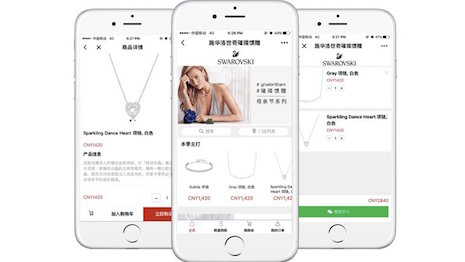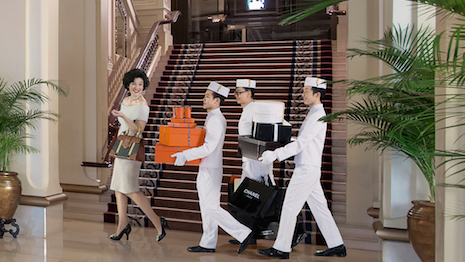The price of luxury goods increased 16 percent in China this year, an increase from the 13 percent they rose in 2016, according to a new report from Hurun Research.
The majority of the price increase can be attributed to three categories: yachts and aircrafts, high-grade tobacco and alcohol and leisure activities such as golf. This data comes from Hurun Research, which released its "2017 Luxury Consumer Price Index" to gauge the current state of luxury spending in China.
Supply and demand
The Chinese appetite for luxury is growing every year. Each quarter, new reports come out showing the desire for luxury goods among Chinese consumers growing along with the burgeoning affluent class in the market's society.
In concert with this growing demand, luxury prices are increasing to match the consumer base.
Hurun found that yachts and aircrafts, whose prices rose by only 1 percent the year before, are now up 4.4 percent, suggesting a boost in desire for luxury travel accommodations.
Similarly, high-grade tobacco and alcohol were decreasing in price over the past two years in China, but have now shot up almost 3 percent this year.

Finally, leisure activities saw the largest increase of any category. After only one percentage point increase last year, this category has now grown by more than 6 percent.
Some lower-performing categories included tourism, which dropped from 5 percent to barely 1 percent, and watches and jewelry, which went from 4 percent to 1 percent.
This suggests that the kinds of experiences that Chinese consumers can best enjoy at home, such as leisure activities, yachts and education, are increasing in price. But the products that are decreasing are the ones that many Chinese travelers can purchase while abroad, such as a new watch or handbag, which are more often bought from a European boutique.
For luxury brands, this means that they should focus on appealing to Chinese travelers abroad for some categories, such as apparel and accessories, and target them at home in China for other products.
Chinese luxury
The United States is becoming a highly coveted travel destination among affluent Chinese consumers, and due to their spending habits the demographic has proven extremely influential, according to a new report from YouGov.
Chinese affluent look to purchase luxury goods while traveling abroad, and Chinese consumers spend the most out of any group while traveling. YouGov's Affluent Perspective 2017: Chinese Luxury Shoppers in America finds that 56 percent of Chinese affluent are planning a trip to the U.S. within the next two years (see story).
These travelers are buying luxury goods from a number of Western brands, meaning that spending on those categories at home is stagnating.

China's WeChat will soon be compatible with North American luxury brands. Image credit: WeChat
Four Seasons Hotels & Resorts, French fashion house Chanel and beauty marketer Estée Lauder secure the top brand spots in their respective fields in regards to relevancy among Chinese consumers, according to RTG.
The RTG consulting group has released its "Brand Relevance Report 2017," which shows that brands in China are becoming quicker to jump on growing trends, helping them to stay on top. Many Chinese brands are making waves overseas throughout all industries (see story).
Hurun’s research suggests that luxury brands need to be smart about which products they market to Chinese consumers and not just blanket them with marketing without a keen strategy in mind.
{"ct":"ykc8Z3XIu46qbBPEbBd0Vb6e2JH\/3pW8SCsPMuR1xy90F4uakCc8t5+luxGE16bOh0Gkf8a4dVXkquie0bj6P8uxAW+x7JpltPCEgfgsl2VJwPgleMtQobsk3jNKv868Pqk8c\/EQJfrt0sPRiO3c+xwGFQ\/F2eitwSvzQSudX4kfsFAPqQXiqaBfF5HcVrQvjfSA+9wVz0yLKw9JQo18+UB1IO5I5iK0IQYaE7aouJDsAoYbxwL9C9+pIsZvAPPcCFQR159kuTy7lEKk+rll21ylv0LqoPgdNVv6i2rurEoieKiBiQSs3giwwhES5cTfLAbRQHyY2sXSap46JxJ2JO5A5WdSXNxUaBw8bh94QcUzyKjSFmunVGOs8rUskAyodr0OuuX2yC\/s3RbGeOhw9S4Qw334Wb+ScC0ZaVVI\/eJG9mTtWe+YbwD2zJGNPZest0HF70YlWGIRHaj\/QDxr\/b7MGmn1DWZWROa0ntjBXkXJZjqsRYNcCzqbHBQc4Rr6tMM4r20YxAQO5filBbsV90ZlZ81jdHyc2Qe2Q4pqZ5FJ85F1Gkc\/1aVFRT5nbolFkFjqO2kjAqpUuUwKik\/ATezewNx3K6loI5KQd6J66nBCd2TS0Ss6ckscIuCV9RBsJ4TJ7tDYxbtjQpzavdyU\/YEFxL6PTifQtcdJsxK\/fbJ9y847+iYGsp03jakLMldg54h6hhbldGMmxttIwZUbOl9qzxcZsSbsa7uec5pnxE+PQlJ2fGG57jqfQ\/ehCSDY3mFDD9H\/Zhd+NDaVKE+PFt\/JHor40Msdit9s6H6\/scV+KqdINXhT4kMH9YJ4KEzfVMAY3y3GmPoxI7hrxMoMcogcXxybaLKn06gOg\/SaPoGx8ys8CsXrz3x7aUxmypnLX5VcGkJ1XFR0dR8zCelq4JweUbxsX7OIghonfGpxlHYdtbNJIj7GKpGjTBweUv74EW9ZxeS+3vebQX5QyKzflUqjoYmURhh2RRYFe2ZZIdr2qoPiUeLLgVQxsE8b495E4SoFmZ0JIVi2stcv5oQCF89SrSTkJD8wb+3R9DVGMvsubhAn0MrTmehUmfScpn6\/7Wp6cL66Os3tTHnfFckadSPRoCNXlyUc1WCLlN2BF8to4DpG8iI9oRXX67EieDRcL\/upVqAIh6MDSJzfX9kUlQqA7Xc3KnGLDFOhUZVmOXJN92X6DDfNx4XMTY4hlX3REXSEi2x+HQb1eWMDMo7BvKL5WJOqhxwgZblAas5UaNHgC\/OWqGjvfU2Cw89kIJYi4A9Pcforh2OxR5WnqYALfUzEcK75jpYCR4K844fPJrWPsp1bSNjzdbEjmsdlXoEQ3ETBAhrQGC2WWbH4cBw11v156gFYvAxE4UPKRml0oIyBEx4uy9l26PdkQD6Ky+LHX7ytqbQx42EZcKS6oFQj3AD6pgQ6K0MO6QH8atGHNXYXRAJE4FF0a8Nkuu+iQuU0AMXI+8LGrT8AM5Jm67hdFuLo77amezhxPl4yDyHtehMQDWDYGiJY\/U0NBnID1EuRJpnGWE0izabGagIw67UWzZ6KmygjhxhPT3WYO8Oi6hDD1tfcLnFy4\/Jut\/qz9VbC+aTDhO4uNOSOx5lVgWvxe7qCcv4gyKSEXdew+cO7Hds5kfz2FpQZ8E0ZGLXKAKcxVm+P\/x1WV2wc26ctQXGQp6fQuZKZGeufR1VplFPpzY1jnX+3vlm2f8Fy9\/OA3gtH35l+\/Np5z8gCnDmqcZIEpZC0X2Ee\/hZQLzwQy+mGRA+tfmJZWkc8vKnDcrcJyz0EWnCHuyy2VpR\/H2p9PJuer\/hJ6CrZuRQcE5zw1vopvRLoAgCQu9HwboEYeAl0Q5DnzooM3UacBS1kmulKSTE0T5hINBwgsVc7EjDtuB1tWNH6m4tKjWl6\/N3CA9BPuo2VynZhx6F9+zmKlv\/KpfFphXsedXI95NsGnjGwa1du+P6dDn1Le1USY82Gpb9vLs\/6isdLYcnxJcHPAPa+\/FzpDVObIflVMDrzh+OemDwwNKK97AekOK\/Q0JsUhdBefyg0JTLYFYxlZgSnv5eBxX5aYZSxIQABdPpkZMedFiQtN9tDvm2CMcRdvDptqpymDKGdE6\/cIidJLv6CJ4KJEZIUFpUztgH1zCJHXbTzirDbffWOBayZ2ur60S0DT77LJTZrtj0jvnkEvkoQyJp5sPk4m\/P4XcEtA6KnlIet7cNvlMRqmDLqrangdg5LTOzxVgBfj45SWCp8BzEPRZP63WCjKcPDxyejlIS5hWVdfY9lwOenIS9xTFLF+N+pWPUnEGA+vIvaH5opC+Q0twSem0qPtFTPoXyMFVeeIzqvy12Zp8OIr4L4q5jyl53Sqo13Bsj94xVlygbSa6Bufm+05AN208sWjyUWJDhMp31n5JfIV\/YNGKnm0lv0NBb4PYMiGJ2gtq\/794mHsUihjknQxLvKeMAohz2eVnWzAROx5i7ZkZAFofyjmV5wc7BJ63FGphXbXlFxCpWLfr6aJgiNjrjKrpqyor1Eo0ScEFcknpyf4hQosT8M46LjWg8Zs2N08N+P+\/EebqfUnt7BRrI1kHqm9vEMGKfcKmoT+xmDiM7DSWm8aCTTHxtNUApSGYHXSPddfHP7A\/SySAJr655xTsH99xUTuVltVvMTpPCdWYqPnOoS0w1nH78OW2GnH4Mj1TyFIMXi2nPxhSvSuJKYqNksj2aDYS7\/j9uOJ\/86mYYy4eKpLJgWDYJGg95g3mW85vNzjX7y23zrTbfFy7OVf0LLfPR5a4tBdfGyDdXImzo4fNV\/41E7L9uOV\/6htaRMw3JyZvQnzkdAXKRU5gsXriZXAk8p+nNWKIrXCOvk8HYj\/1qry7Z4Kiv5vQSEQOzs6EEaqIuLOz2Mo5\/FNsXdrqcxwZw+8BeiOC63NMNUo6T5UhULw8M4LFd9FgoE5vTe\/nUspR1TgSf\/EC3xqRtZSoi9JnTjO6sy\/3HuBP4707grtZiE9zRZh8dzjOH8j5uF2C1SYgkxxbRvm+9IMihcFzwVHyWZ9L51hmr\/eF0c3Guydjx6P4rHPwdLjz3SEo1t0XoaV26Zt7uHqzdStsZug15zu55c+WJskxrpWLVrnYZVqtbUfD+TVcVT6zZYEhMbVm9gFZcuyLGU\/rNsMSW0IurrHN1luA2Qnm3J\/zAdxs1USWPhWND2n4BtXkjW2GDEzT7ipAV\/uTuTDu61Otdy1oMZSpdrt\/GCJelBRD4XCxCRqyN9AigbUO5XzNDC7U3WxQPdf1Js7vq2VD1sBhvHrYp\/PdSfDSjj1XV\/fNJPb2UESrKh4TFRSsit8gvmEFXmvKsKVBsorkC9KO+qSc37Jt4HOShnN\/UDB78KwQlii+YqxuZWtcEJitkW9iKQWpJ\/Xrm0awvDUWZB4NzRVqkbS6j25QX0B775+cmLkwrdqxm4zVwNJ\/7X4rATS3m\/PhtG7O37RUV09by1JNMW5jDOoUIKuxWP0pjwu+\/JkXnZ7LIlIcYt1FD70TgS4o83r845CfaIvQHiMsFiXySc\/DrZDRTpHbTKrdnFjQg4XbCRVylYgI7NDjuBA5Oqgyq0eMPvraFQSx6F2YIQoOwxnhqC4b\/e\/tOVgWGoiyIeeT\/i0Xu1mcLGu0l3ijAmey5hdHMbA69h\/S76nWIt72Qc9JIyDvDagZlUSR7zMZnghSmSR0Hue9mXZM\/PJCPD7Xh7aDM7nCd\/vxjYAZsHUmoHXuLNCzpuADxvJssI+6EIaryWffdqW5FZbLMpYPKxtd7kZZXQklKNdmw+mCNZjasmcTejX3lHkJiJ1TCur4gNUgYg5WobrhJVLVywky1r3WS5SeyTeDbarCLLMqt1k3heymMmJj9Fe9bIAQ\/J6kmYOBjszz4VkCuF6H7wEiWV6P3\/5fYMMijbnSh5arX3aazE3EePCkbcPrpykXkcbZFq67NyWjDER\/vG2gFnRunTBdRYA4zhWrcKXaszJ1rHBa+UVdU41SLAkv+ZHkf2EkuFprQoA70lQNsaHsI4\/Ty8dnzkVm2KIssumDDZK9gVyTRrGX6JC6uU4XLt2WMQ3AOuVBJfNykfLr+h+in3qZN5rJmqu4eRr8cUDgPCY6ykaU75vgBKfrpeh0bzgbv53rEwMg7Nwh08rtZtu7+rc3JKWm6x55jEFR7MM+xcSb6tedolIBhW8MaB7cO0WFUxtONSPPAWGokHB71Vg+hj01Wt3mGppnX7SsJIPECljNCFX2GjEM6aWsCt5lRGbJdEw\/9pg7AttheqkDf3z53eKoJqMiI5hr8mCQf6yoNNn0p\/54lqvYC3W0s0DYaCa8PUJdFTZmvJidi3XHyBGlH9QtKa0voIAscL2V\/CX66AcVQADZrqK2t9XYd4Lr5QjgQRfNK4IVSadNOiuB7uVFrtssCbUthEX1LRg9EH\/0Kz1Wk5bukBDyOy9pWvGOO6DvAWOW0FBW7MhExkyt0ksa7FhpIeWMIdtg3dbaziPajgUdiX9bAhpVNKGY9Xd9OVbDEpceOYGMjxD+pI59KFePnbto91+ExLpGxIGT3rTCVYeEDPgPPrtPDr1tg8wK8rNZ6armlDFkn8j3aLXP0M0wPEX\/te\/xSVK3zVQGQU4+KH75ATPPwpijLT20Tw3DZTwCWZdAW6q213S\/YC2NrL4Qrrt6Mlc2qA2drVKwX64BHUI\/0mfpMq1nPTYzvnln7rVcRVNn+Slak6mW+fsm\/voXDn88Ep83tRlWTrQuGjvB8HLwIVqvSc9wRZoA+D8cE3zIErHxKHvDvJ5IrBNIlxzDhVFCNpKr4Qb9EmIY314eRQ35fNl868RBeAUkVlap5mf2+K3rGrlUWHLf9bcz4Sht7A9x8YPnYsOj9ppJa4UVcLeh4ECYXvfDndkN3C9iw\/vxa8QldwbO7Cw9V06iwkveWhlTvPA4vweoLPXBrX++sZG3vySspYxMxb0ei7\/WPS2CcZTnqpKBPyZRMupKe0rgiMWJTYPDNbd2LHEI1Bv5ztiauphnxvwsKe0oMzCAOjzdwSk4d1tyjYGOgRIZdPVW\/kNhkE\/qFUbHImKqNLM\/zqyLhY0gaS1m5\/P0O2r1uaUg3EEOCmMurHpOyZw38\/wR5rJutkwBlzyoksxHWgtjLJSaEqhcGTbPScANP8QF2jAOqLP+yoHfMD1AxVqPXYRPjsQxd2layp6fEGtBFrboS7oT4NfMCvgbj4g3TeBm1D1L\/6part1cWDfdF5SKcrtA\/Z9vaun0kAmXL+y6nzw4LUdopBPUsiRbrWndAMwsDeUhao5m02Ca3gZaPz72xbihfycpz0utAh0ZJj2sJaY2uYk4RuXrIYdeXmcdLmanvZvw2lVGEgOnDIS52n7QgKAj\/wZJFJ6lGhJyocJLDZKxIIH395Dp2y3IW9VgXiyqdkcgDXGGx4isVLnY+2o71rgNjhQmA2JxnFKoWfvBock9CqgyhlycmkvRtLJmmjmgYV5qQhpPvF2xJnT7SVhS9kXp32B860gRQ8cLCq3Q3PZnG2yX05Xx4qgvDVXhT9KqP\/\/gm2cXAbtNgmgqEntQKf0evYHP7SUnWpdav0gtQcpvE6yIL8dGXuv3NhuRxgUDhaH\/kUsnBqtEBcp1KbVFbD17YFI1JtMKEZr80XbU2Vjb\/mpTToVVhJ5H0UrAulPrKcqokuVGCxkry8fnx+XpLx\/9HdiIH2W\/KKspxryG6srflc4V1mpUms3kohlccdtux6D9WAQ3Z6XcWVMMU476blD4z8+V896\/OCg+3hgRsMxi0xNjF4JUDvQT5Msc7tqTdCMr21kCDIXtgakdCIJgWAxq42kWdeTPv\/TvVNZX2Oaqb7Ul4Snky6qtUYcTbwc5mUnrz3ZvqLsj349Hz7oVkHe6yDCuD4zHR\/n6kXBPuwZsoMqEcALYmLVTWuz70LkIGZzOVl\/UYFAOdF1hZhWElwNLWgPQdRUlCwka7i9zACRS3RYEzH7jK2r+3+hMlJKMDYnuPNw4d86MRwU8PKAjL39nb9CZQsgzBfMWWdh3BU9HR3xMw8Br0k3E5WOd3Tmto4ze9Dg0ZJVv7OBRftYDctiEvP1YR5tM7vAD2C6gBIdbYB2C99RlGtP07+uVvozTvIo6cARcUGY6GcIPv06cNwjiGMOrrlmEPaAPpOq8o1H3lZZl1kSmnxBBqTaf1rtk1zUGQxmeehyvUBaFBlJ4vU7VvrqZ6ighs6wT1\/yEP4iDEWEswstN2xLhNzRo+55nqlkvIcgVWYoQ\/P0VAQ4LxpMy34kJbrhTlR7fdMkx2tK0bA9AtZhZo\/iETu27SvPA==","iv":"075f9a6777e12a14d870dbdf58e69a43","s":"cca3535b9812e88d"}

 Chinese luxury prices are increasing for items that consumers usually buy at home. Image credit: Peninsula Hotels
Chinese luxury prices are increasing for items that consumers usually buy at home. Image credit: Peninsula Hotels